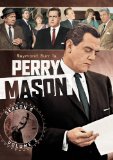Erle Stanley Gardner wrote crime fiction, and while many of his 100 or so works are unknown to most of us, he created a character that has become as identified with criminal lawyers as any other in fiction. It was in these crime novels that Perry Mason first faced a courtroom. He developed a style where he would investigate these terrible crimes his clients were on trial for. He would find the real killer, and in what has become a Hollywood cliché, reveal his findings in a crucial moment during the trial. While we may not remember the novels, we all remember the man in the persona of Raymond Burr. Burr had a commanding presence on our screens and enjoyed a well deserved 11-year run as the clever lawyer. What makes this run so amazing is that the show followed pretty much the same pattern the entire time. We always know what’s going to happen, but we wait eagerly for that gotcha moment when Perry faces the witness on the stand. We know when he’s got the guy squarely in his sights, and we can’t sit still waiting for him to pull the trigger. OK, so maybe that’s a little over the top, but so was Perry Mason. From the moment you heard that distinctive theme, the stage was set. To say that Perry Mason defined the lawyer show for decades would be an understatement. Folks like Matlock and shows like The Practice are strikingly similar to Perry Mason. If you haven’t checked this show out, this is your chance. See where it all began.
Raymond Burr did not carry the show on his own. There was a very fine cast of supporting characters. The most famous has to be his faithful secretary Della Street, played by Barbara Hale. The two were inseparable. Perry had the help of a good private investigator in the Raymond Chandler style. William Hopper played the tough-as-nails Paul Drake. One of Orson Welles’ famous Mercury Theater Players took on the part of Police Lt. Tragg. Ray Collins starred in Citizen Kane as the political party boss Gettys. He was a fine example of top talent working in television. Mason was often pitted against prosecutor Hamilton Burger, whose name too often reminded me of hamburgers. There wasn’t anything funny about Burger, however. He was a worthy opponent who drew the short straw most of the time because he was up against Perry Mason. The task was accomplished with a lot of style by William Talman, a one-time evangelistic preacher.
Here you’ll find the last episodes of the 6th season. So, what kinds of cases was Perry up against then? You get 14 more episodes on 4 discs. It all starts with The Case Of The Prankish Professor. When a college professor writes a tell-all book about the love-lives of the campus he turns up dead, but there are a lot of folks with plenty of motive. Perry has to dig through the dirt to find the real killer. Raymond Burr had to episodes out while recovering from surgery. One such case was The Case Of The Two-Faced Turnabout. Here entertainment lawyer Bruce Jason is played by Hugh O’Brian, and it looks like he’s in over his head when he has to defend an infamous columnist for murder. Another such episode is The Case Of The Surplus Suitor. This is an historical episode because the guest lawyer Sherman Hatfield is played by Walter Pidgeon, who was originally cast as Perry Mason. He pulled out at the last minute due to the pace of a weekly television series. Now he gets to play the role, sort of. Burr returns full time in The Case Of The Golden Oranges. Here his job is made extra tough because his primary witness is a dog. On television it’s never a good idea to conspire to fake your own death. In The Case Of The Lover’s Leap, the guy ends up dead and Perry has to defend his partner for the crime. The set ends with The Case Of Witless Witness. Perry defends a judge who might have killed a witness who was about to finger him for corruption. Perry has two problems to solve. Did the judge kill the witness, and is he really corrupt?
Guest stars this season include: James Best, Natalie Trundy, Julie Adams, George Kennedy, Faith Domergue, Allan Hunt and Michael Rennie.
Video
Each episode of Perry Mason is presented in its original full-frame broadcast format. The episodes are in black & white. The picture quality is pretty good when you consider the age. Black levels are completely solid, allowing clean definition in the shading so necessary to a black & white presentation. The brightness is a little low at times, but nothing that muddles or damages an otherwise good-looking print.
Audio
The Dolby Digital 2.0 track is basically there to service the dialog, and it does. There is some distortion during the theme when the music is considerably loud. If you keep in mind the source material, you can’t expect anything more than this.
Special Features
Nothing.
Final Thoughts
This was an important half season of Perry Mason to be sure. Not only was the original actor for the show given a chance to finally be the Mason-type role, but Kohn Larkin appears here who played Perry on the 1950’s radio drama. It’s one of the better sets to own. I still question the half-season sets. At this rate I’m not sure DVD’s will even still be around by the time they finish. We’re finally halfway through, and it’s taken nearly 7 years to get here. I’m sure they have a good reason for the tactic. “Even the devil has his advocates: I assume your case is better than his.”





